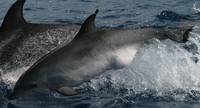Exceptional spotted dolphin sighting
Mysterious phenomenon
 La Gomera, October 2009. During the springtime field season we encountered a large number of spotted dolphins (Stenella frontalis), a species present year-round in the Canary Islands. In one of the groups, containing a large number of calves (which is typical in springtime), we observed a young animal showing an extrordinarily swollen genital area. The reasons for this phenomenon were not known. Luckily, we managed to photograph the animal during aerial behaviours.
La Gomera, October 2009. During the springtime field season we encountered a large number of spotted dolphins (Stenella frontalis), a species present year-round in the Canary Islands. In one of the groups, containing a large number of calves (which is typical in springtime), we observed a young animal showing an extrordinarily swollen genital area. The reasons for this phenomenon were not known. Luckily, we managed to photograph the animal during aerial behaviours.
Comparable cases reported

(c) Denise Herzing
For comparison, the image on the right side represents an adult female spotted dolphin showing the typical swelling of the genital area during lactation.
After posting this information to the international cetology email discussion group MARMAM, we have received a multitude of comments as well as a variety of ideas and diagnoses. Similar observations were described, involving several spotted dolphin calves in the Azores and a juvenile/young adult male grey seal in Cornwall (UK).
Many possible diagnoses

(c) Lisa Steiner
Potential reasons for the abnormal swelling in the spotted dolphin calf included the following:
- congenital umbilical hernia
- congested mammary glands
- a “good slam” causing internal swelling and hemorrhage
- rudimentary hind limbs
- some type of tumour
- parasitic/bacterial infection (crassicauda, brucella, etc.)
- contaminants responsible for dysfunction of the endocrine system
Moreover, a small animal veterinarian explained that in young cats there is a disease called fibroadenomatous hyperplasia that makes the mammary glands swell quite significantly.
Puzzle finally resolved

(c) Cetacean Diagnostic Lab, IUSA-UL
Finally, our colleagues from the University of Las Palmas/Gran Canaria (ULPGC) resolved the puzzle by describing a similar case they had a few years ago: A stranded spotted dolphin calf was necropsied and the ULPGC pathologists found the reason for the swelling to be a bacterial abscess, most probably caused by a (secondary) infection of a Phyllobotrium delfini cyst.
This infection could have been caused by an open wound, and the abscess apparently had grown exuberantly so as to cause an obstruction of the ureter, which in turn caused the death and the stranding of the animal.
The remaining question is now, why only young animals/calves have been reported with these symptoms…